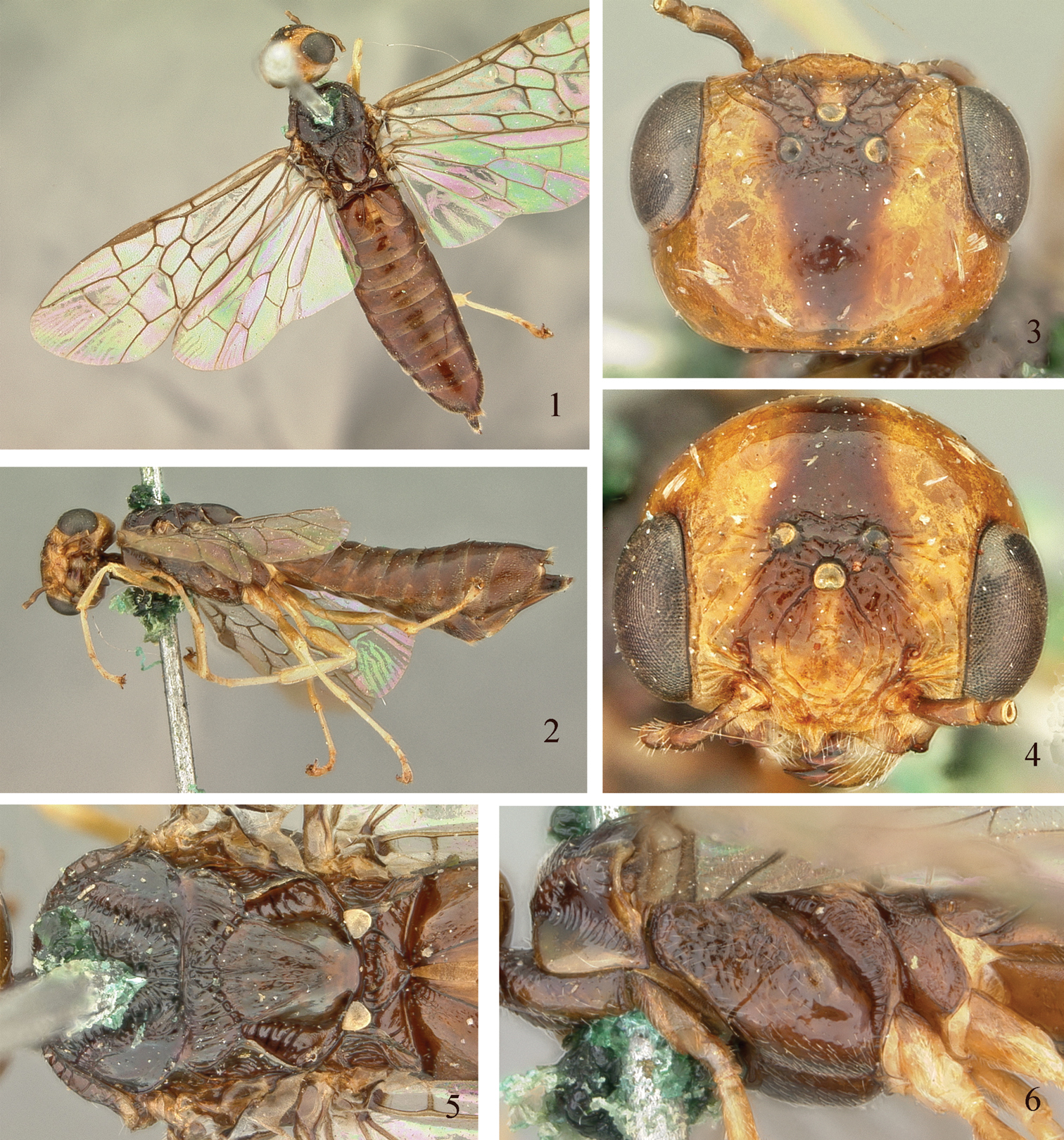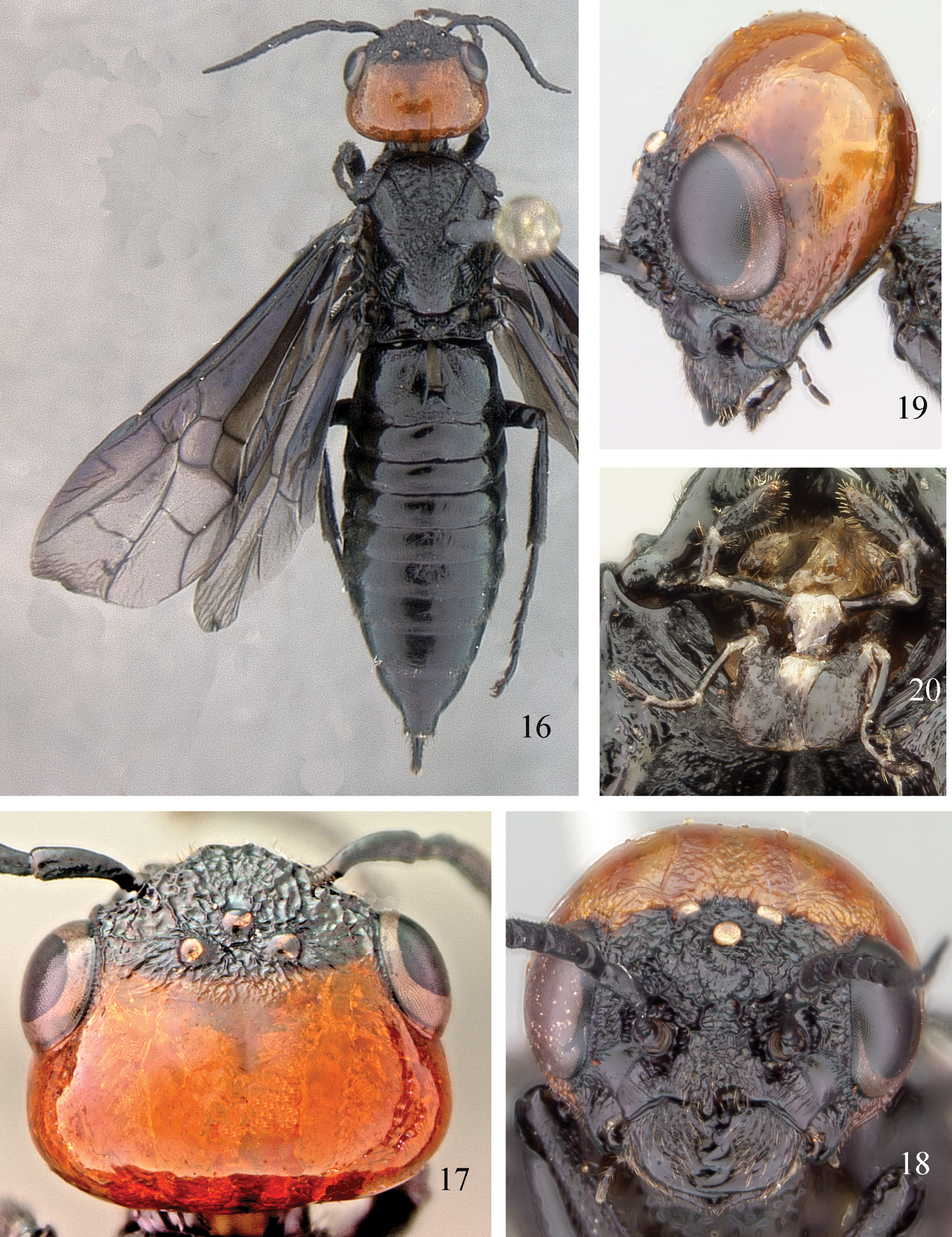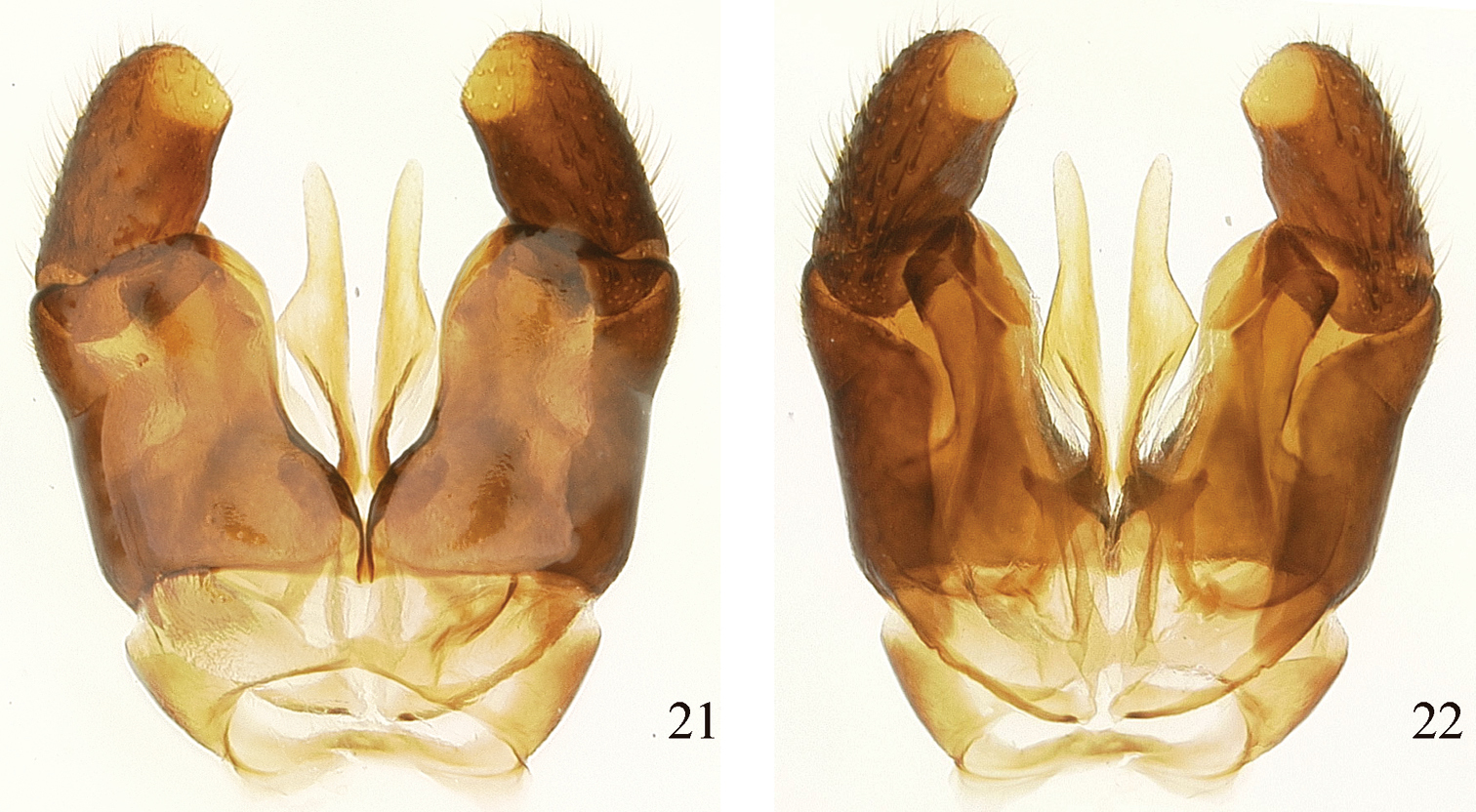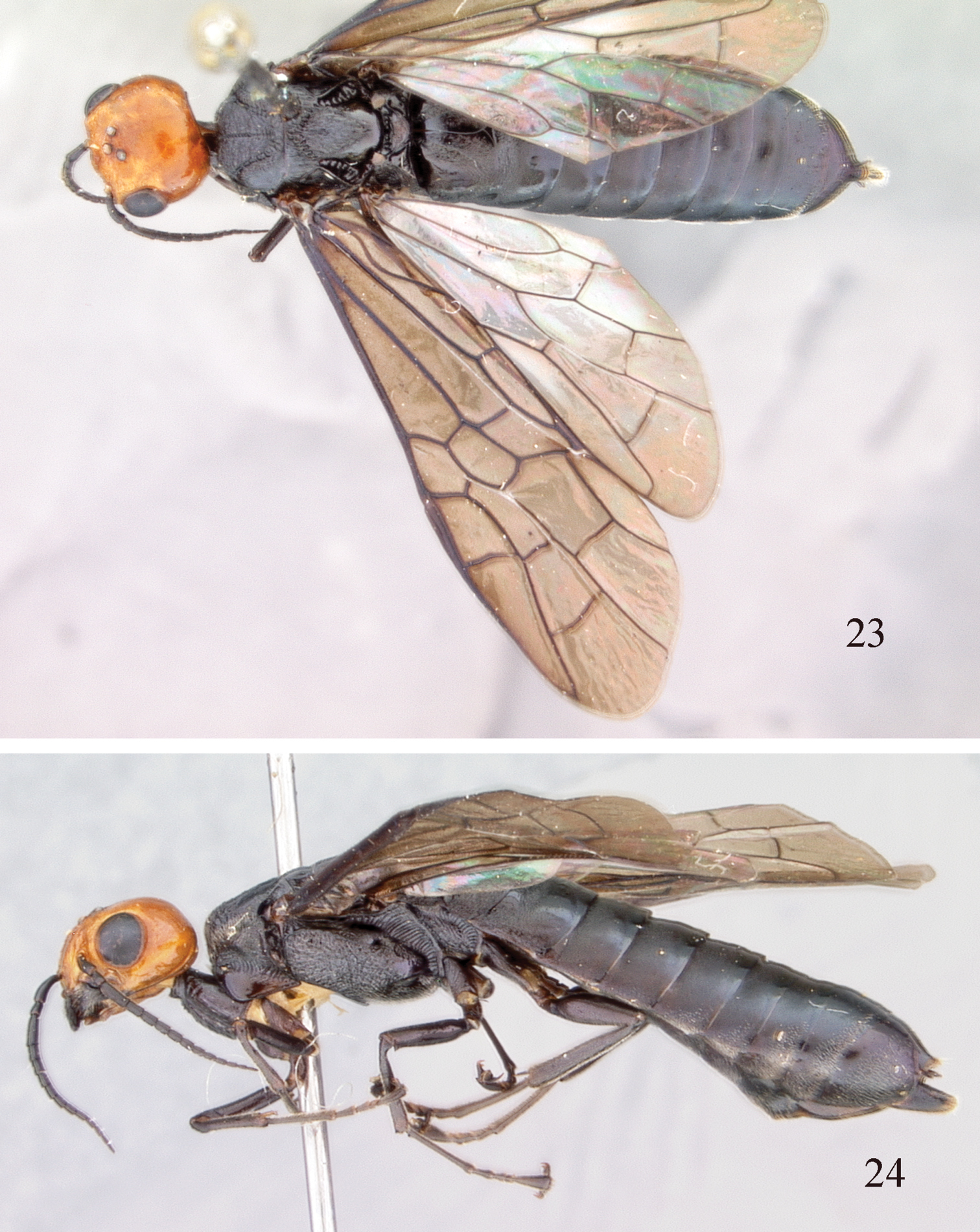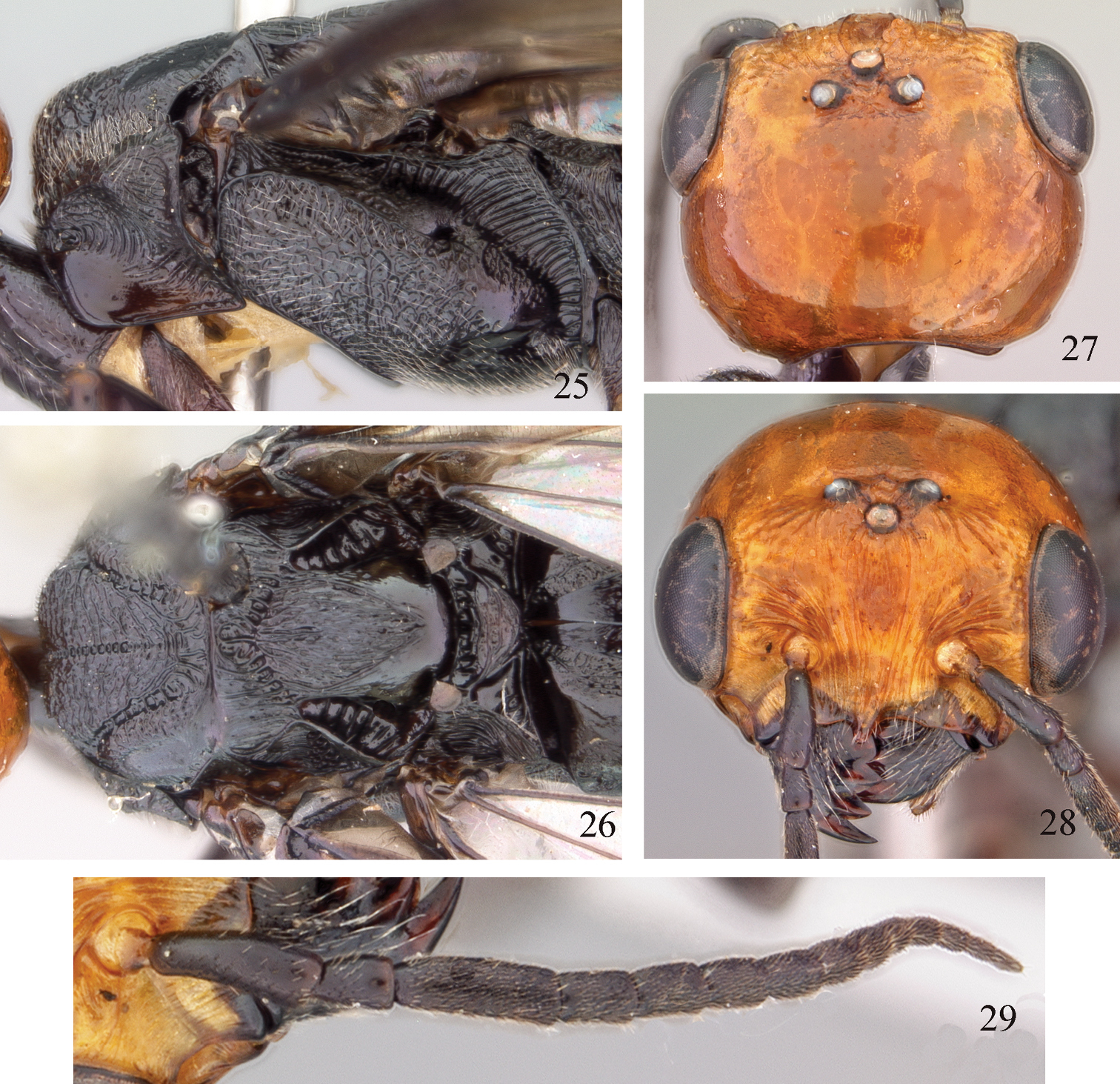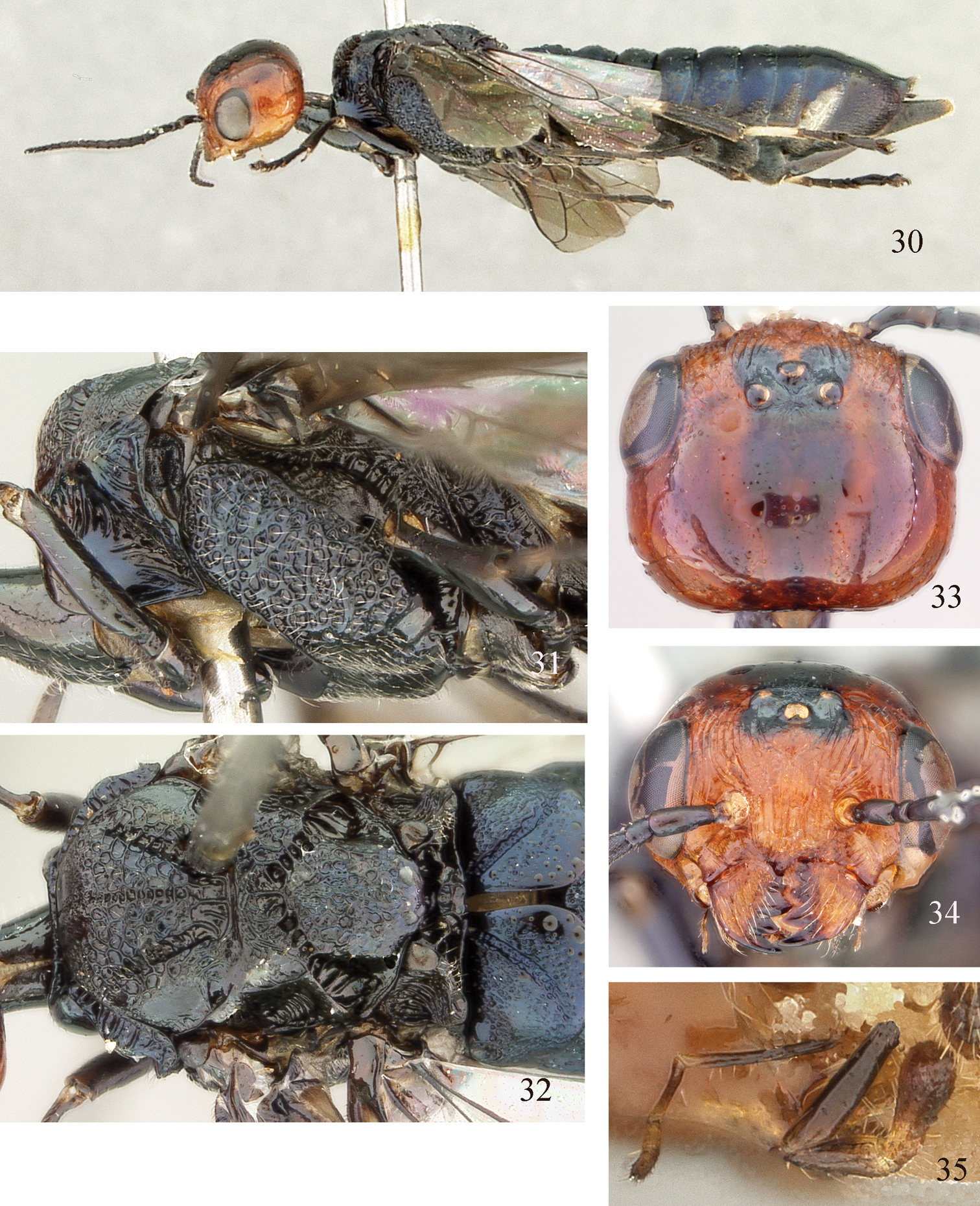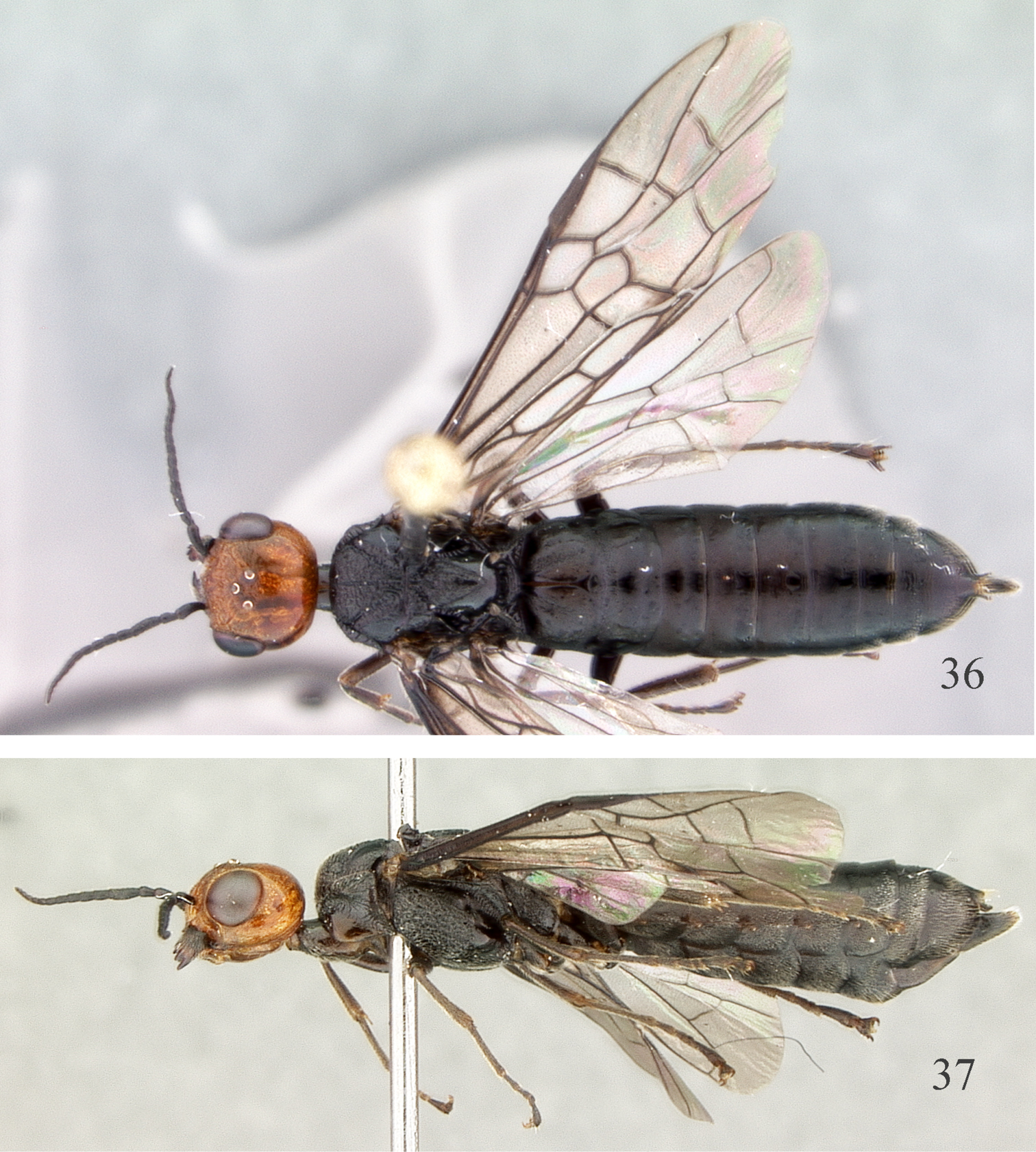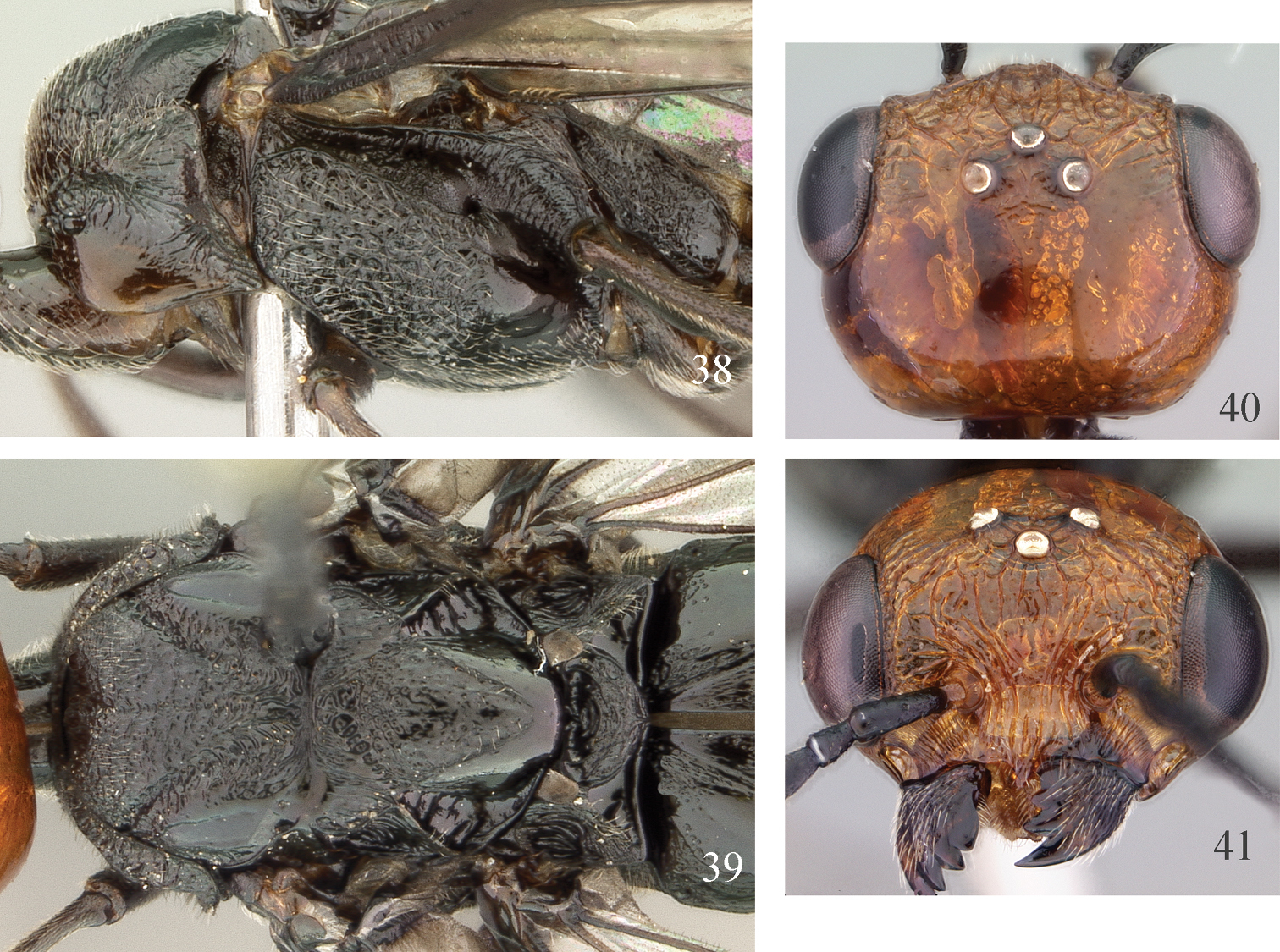






(C) 2011 David R. Smith. This is an open access article distributed under the terms of the Creative Commons Attribution License, which permits unrestricted use, distribution, and reproduction in any medium, provided the original author and source are credited.
For reference, use of the paginated PDF or printed version of this article is recommended.
Five species of Euxiphydria are recognized, Euxiphydria leucopoda Takeuchi, 1938, from Japan, Euxiphydria potanini (Jakovlev, 1891) from Japan, Russia, Korea, and China, Euxiphydria pseudoruficeps Okutani, 1966, from Taiwan, Euxiphydria vietnamensis, sp. n. from Vietnam, and Euxiphydria shaanxiana, sp. n., from China. Euxiphydria subtrifida Maa, 1944, is considered a new synonym of Euxiphydria potanini. A key and illustrations are given to distinguish the species.
Woodborers, Palearctic, Oriental, Hyperxiphia
Euxiphydria is an exclusively eastern Asian genus occurring from Japan and eastern Russia south to China, Vietnam, and Taiwan. Three species were listed by
The only host record is Acer mono Maxim. (Aceraceae) for Euxiphydria potanini (Jakovlev, 1891) (Krivolutskaya & Stroganova 1966,
Material used in this study is deposited in the following: National Museum of Nature and Science, Tokyo, Japan (NSMT); National Museum of Natural History, Smithsonian Institution, Washington, D.C., USA (USNM); Senckenberg Deutsches Entomologisches Institut, Müncheberg, Germany (SDEI); Entomological Laboratory, Osaka Prefecture University, Sakai, Japan (OPU); Entomological Laboratory, Kyushu University, Fukuoka, Japan (KU); Hungarian Natural History Museum, Budapest (HNHM); Museum für Naturkunde, Humboldt-Universität zu Berlin, Germany (MNHU); collection of Pierre Tripotin, Mont Saint-Aignan, France (PT); Institute of Zoology, Chinese Academy of Sciences, Beijing, China (IZB).
Images were obtained using an EntoVision Imaging Suite that included a firewire JVC KY-75 3CCD digital camera mounted to a Leica M16 zoom lens via a Leica z-step microscope stand. Multiple focal planes were merged using Cartograph 5.6.0 (Microvision Instruments, France) software.
Resultshttp://species-id.net/wiki/Euxiphydria
Species are typically black with a contrastingly orange or mostly orange head (Figs 1, 13, 23, 30, 37). Antenna with 13–19 antennomeres, middle antennomeres dilated and compressed (Fig. 29). Head polished and shiny on upper genae and vertex to about level of lateral ocelli, variously sculptured on frons below lateral ocelli; in front view, inner margins of eyes parallel to slightly diverging below, lower interocular distance 1.4–1.7× eye height (Figs 4, 18, 28, 34, 41); head from above with distance behind eyes about equal to (Figs 3, 40) or longer than eye length (Figs 17, 27, 33); area posterior to upper orbits in profile usually longer than eye length; both mandibles 4-dentate; maxillary palpus (Figs 20, 35) slender, with four palpomeres; labial palpus (Figs 20, 35) with three palpomeres, first two palpomeres slender and third palpomere dilated, oval, with sensory pit. Forewing (Figs 1, 23, 36) with cell R closed, vein 2A+3A complete. Hind wing (Figs 1, 23, 36) with cell R closed, cells Rs and M present; anal cell present, petiole subequal to width of cell. Tarsal claws with long inner tooth near center of claw, about half length of outer tooth; claw of hind legs larger than those of fore- and midlegs. Tergite 10 posteriorly tubuliform, strongly protruding caudad.
The above combination of characters will separate Euxiphydria from other xiphydriid genera. The only other genus with four maxillary palpomeres and three labial palpomeres is Carinoxiphia Wei (in
Four species were described prior to 1938, Xiphydria potanini Jakovlev, 1891, Xiphydria ruficeps Mocsáry, 1909, Xiphydria ruficeps Matsumura, 1912, and Xiphydria maidli Zirngiebl, 1937. When describing the genus, Semenov and Gussakovskij recognized and separated two species, Euxiphydria potanini and Euxiphydria ruficeps (= ruficeps Matsumura), and
Key to species
| 1 | Legs entirely black; abdomen black (Figs 13, 24, 37) | 2 |
| – | Legs entirely white or black with basal third of hind tibia and hind basitarsomere white; abdomen with white spot laterally on eighth tergite (Figs 2, 30) | 4 |
| 2 | Head orange with frons from about level of lateral ocelli to clypeus black (Figs 17, 18); frons densely rugose (Fig. 18); axilla and mesoscutellum reticulate (Fig. 15); wings black, paler toward apex (Fig. 16) | Euxiphydria potanini (Jakovlev) |
| – | Head entirely orange (Figs 27, 28, 40, 41); frons with irregular carinae at least close to antennal toruli (Figs 28, 41); axilla and mesoscutellum with irregular longitudinal carinae (Figs 26, 39); wings almost hyaline to very slightly, uniformly infuscate (Figs 23, 36) | 3 |
| 3 | Head from above narrowing behind eyes, distance behind eyes equal to eye length (Fig. 40); sculpture on frons reticulate in front of ocelli with carinae close to antennal toruli (Fig. 41); carinae on mesepimeron short, irregular (Fig. 38) | Euxiphydria shaanxiana, sp. n. |
| – | Head from above gently curved behind eyes; distance behind eye much longer than eye length (Fig. 27); sculpture on frons consisting of more or less parallel carinae, without reticulations (Fig. 28); carinae on mesepimeron long, straight, almost parallel (Fig. 25) | Euxiphydria pseudoruficeps Okutani |
| 4 | Legs white, apical tarsomeres brownish (Fig. 2); frons reticulate (Fig. 4); head from above strongly narrowing behind eyes, distance behind eye less than eye length (Fig. 3); axilla and mesoscutellum with irregular, longitudinal carinae, smooth and shiny laterally and posteriorly (Fig. 5) | Euxiphydria leucopoda Takeuchi |
| – | Legs black with basal third of hind tibia and hind basitarsomere white (Fig. 30); frons with almost parallel carinae (Fig. 34); head from above straight behind eyes, distance behind eye much longer than eye length (Fig. 33); axilla and mesoscutellum entirely sculptured, reticulate (Fig. 32) | Euxiphydria vietnamensis, sp. n. |
http://species-id.net/wiki/Euxiphydria_leucopoda
Figs 1–6Length, 9.0–12.0 mm. Head orange, except medial black stripe on vertex extending anteriorly through ocelli and anterior to ocelli as an inverted V (Figs 3, 4). Antenna dark brown with scape and pedicel reddish; Thorax black with tegula, anteroventral quarter and narrow posterior margin of pronotum white (Figs 2, 5). Abdomen black with white spot laterally on eighth tergite (Fig. 1). Legs entirely white to yellow except apex of apical tarsomeres brownish (Fig. 2). Wings hyaline, veins and stigma black (Fig. 1). Antenna with 13 antennomeres; length of first four antennomeres as 1.0:0.4:0.8:0.5. Frons sculpture reticulate, especially around and anterior to ocelli (Figs 3, 4). Head from above strongly narrowing behind eyes, distance behind eye less than eye length (Fig. 3). Malar space between eye and antennal groove much narrower than groove. Axilla and mesoscutellum with irregular longitudinal carinae; lateral and posterior downturned areas smooth and shiny (Fig. 5). Hind basitarsomere slightly longer than length of remaining tarsomeres combined. Lengths of sheath and basal plate subequal. Male unknown.
Euxiphydria leucopoda, holotype 1 Dorsal view 2 Lateral view 3 Head, dorsal view 4 Head, front view 5 Thorax, dorsal view 6 Thorax, lateral view.
Japan: Honshu; Shikoku (
Holotype. Female, labeled "19, VII, 1920, Daisen, Takeuchi, " "Euxiphydria leucopoda Takeu., Holotype" (OPU).
Euxiphydria leucopoda was transferred to Hyperxiphia by
Hyperxiphia nakanishii, holotype 7 Dorsal view 8 Lateral view 9 Head, dorsal view 10 Head, front view 11 Thorax, dorsal view 12 Thorax, lateral ivew.
http://species-id.net/wiki/Euxiphydria_potanini
Figs 13–22 Length, 10.0–20.0 mm. Black, head bright orange on genae and vertex behind ocelli (
Euxiphydria potanini 13 Lateral view 14 Thorax, lateral view 15 Thorax, dorsal view.
Euxiphydria potanini 16 Dorsal view 17 Head, dorsal view 18 Head, front view 19 Head, lateral view 20 Mouthparts (labial palpi above, maxillary palpi below).
Euxiphydria potanini, male genitalia 21 Dorsal view 22 Ventral view.
Xiphydria potanini was described from a single female from “Chinae prov. Gan-ssu.“
The lectotype of Xiphydria ruficeps Matsumura, described from “Hokkaido (Sapporo)” is at Hokkaido University, Sapporo, Japan. The number of specimens was not given by Matsumura, but the treatment of Matsumra’s xiphydriid types by
Xiphydria akazui first appeared in
Xiphydria maidli was described by
In the introduction to his 1944 paper, Maa stated that the types of species “when not specially mentioned, are deposited in author’s collection.” Under type specimens for Euxiphydria subtrifida, he stated “Mao-Shan, Lungchien Hsien, SW, Chekiang, 3–5.vii.1939 (H. C. Yao), 5 males. Further paratopotypes in the collection of the Provincial Institute for Agricultural Improvement, Sungyang, Chekiang.” A holotype was not designated, and therefore the five males are considered syntypes. We assume they are in the “author’s collection, ” since he stated that the additional specimens are in Chekiang. This was verified by the junior author, who made note that the syntypes are in the Taiwan Agricultural Research Institute Wufeng near Taichung (
CHINA: Heilongjiang and Tibet (
CHINA: “Mandchourie, Prov.: Kirin, Kao-lin-tze, ” “20.IV.40” (1 ♀, USNM, det by Maa 1948); “Manchukuo, Koolingtze, 13.7.40, Alin” (MNHU); Hunan, Mt. Yunshan, 1200 m, nr. Wugang, 4.V.2009, A. Shinohara (1 ♀, 5 ♂, NSMT, USNM), same except 10.V.2009 (4 ♂, NSMT), same except 5.V.2009 (1 ♂, NSMT). JAPAN: Ikutawara, Engaru, Hokkaido, 28. VII. 1981, T. Kinoshita (2 ♀, NSMT); same except 30. VII. 1982 (4 ♀, NSMT, USNM); Akkeshi, Kushiro, Hokkaido, 19. VII. 2002, A. Shinohara (1 ♀, NSMT); Horoka, Tokachi, Hokkaido, 25, VII. 1974, A. Watanabe (1 ♀, NSMT); Horoka—Mitsumata, Tokachi, Hokkaido, 20–21, VI. 1998, H. Hara (1 ♀, NSMT); Sounkyo, Kamikawa, Hokkaido, 18. VII. 1971, A. Shinohara (1 ♀, NSMT); same locality, 2. VII. 1984, R. Kano (1 ♀, NSMT); Arashiyama, Asahigawa, Hokkaido, 26. VII. 1987, H. Matsuura (1 ♀, NSMT); Ichinosawa, nr. Jozankei, Sapporo, Hokkaido, 26. VI. 1984, A. Shinohara (1 ♀, NSMT); Meguro—Chattsunai, Erimo, Hidaka, Hokkaido, 28. VII. 1984, M. Tomokuni (1 ♀, NSMT); Tashiro, Miyako, Iwate Pref., 15. VI. 1986, K. Emoto (1 ♀, NSMT); Akane-rindo, Yokote, Haranomachi, Fukushima Pref., 6. VI. 1980, T. Shimomura (1 ♀, NSMT); same locality, 8. VI. 1980, S. Tsuyuki (1 ♀, NSMT); same locality, 24. VI. 1984, S. Ohmomo (1 ♀, NSMT); Hodosan, Nagatoro, Saitama Pref., 18. VI. 1994, K, Emoto (1 ♀, NSMT); Kamiange, Mt. Jinbayama, Tokyo Met., 7. V. 1998, A. Shinohara (1 ♀, NSMT); Hikagezawa, Mt. Takaosan, Tokyo Met., 20. V. 1990, S. Ueno (1 ♀, NSMT); Nippara, Okutama, Tokyo Met., 24. V. 1964, T. Nakamura (1 ♀, NSMT); Aikawamachi, Kanagawa Pref., 16. VI. 1984, T. Kinoshita (2 ♀, NSMT); Miyagase, Sagami, Kanagawa Pref., 28.V. 1955, S. Asahina (1 ♀, NSMT); Mt. Daibosatsu, Yamanashi Pref., 27. VI. 1976, K. Mizuno (1 ♀, NSMT); Koganezawa, Otsuki, Yamanashi Pref., 26. V. 1974, K. Kimura (2 ♀, NSMT); Doisokoiso—Mitsuzawa, Shimobe, Minobumachi, Yamanashi Pref., 8. VI. 2005, S. Tsuyuki (1 ♀, NSMT); Azusayama, Kawakami, Nagano Pref., 5. VII. 1980, Y. Kurosawa (1 ♀, NSMT); Omi, Ohara, Sakyoku, Kyoto Pref., 16. VI. 1984, W. Suzuki (2 ♀, NSMT); “Aidake, Torigoe-Mura, Ishikawa Pref., 27.V.1973, I. Togashi (1 ♀, USNM, det by Togashi, 1974); “105, Col. Kumamoto, Ibukisan (Shiga), 22.VI.1980 (1 ♂, SDEI). NORTH KOREA: Mt. Kongo, [= Mt. Geumgangsan, ], Chosen, July 28, 1924, Coll. Y. Kurisue (1 ♀, NSMT). RUSSIA: Ussuri, Kasakewitsch (types of Xiphydria ruficeps, HNHM); Szahalin, Csehovo-hegy, Z. Szklon, 15.VI.1995, Ermolenko (1 ♀, HNHM). SOUTH KOREA: Gyeonggi-do, Hakwanggyo-dong, Suwon, 8.VI.2009, A. Shinohara (1 ♀, NSMT); Gangwon-do, Odaesan, Pyeongchang-gun, Yeonggam-sa, alt. 800 m, 9.VI.2003, P. Tripotin (1♀, PT); Gangwon-do, Samcheok-si, Hegang-myeon, Gajeon-ri, N. 37 22’, E128 33’, 6 Malaise traps, 5–18-VI-2007, Tripotin rec. (1 ♀, PT).
Acer mono Maxim. (Aceraceae) is the only recorded host for this species (Krivolutskaya & Stroganova 1966,
Although we do not have access to types of all species, we have examined a good number of specimens and can now give a better idea of variation and distribution of this species in Asia.
Two described species were placed in Euxiphydria by
We have not examined the holotype of Xiphydria potanini Jakovlev. Based on the description (
We conclude that all species listed in the synonymy are conspecific and that characters previously used to separate them are variable, agreeing with
Matsumura’s species, Xiphydria ruficeps (and Xiphydria akazui if not considered a replacement name), is with little doubt synonymous with Euxiphydria potanini. The descriptions are brief, but compare well with Euxiphydria potanini, and the specimens are from Hokkaido and Honshu where nothing else can be confused with Xiphydria potanini.
Euxiphydria subtrifida was described from males from Chekiang, China. Even
http://species-id.net/wiki/Euxiphydria_pseudoruficeps
Figs 23–29Length, 11.5 mm. Black except head entirely orange (Fig. 24). Forewing uniformly lightly infuscated; hind wing somewhat paler on basal half (Fig. 23). Antenna (Fig. 29) with 14 or 15 antennomeres; length of first four antennomeres as 1.0:0.3:0.8:0.4. Sculpture on frons consisting of straight to irregular carinae, not reticulate (Fig. 28). Head from above gently rounded behind eyes, distance behind eyes much longer than eye length (Fig. 27). Malar space narrow between eye and antennal groove, much shorter than width of groove (Fig. 28). Axilla and mesoscutellum with irregular longitudinal carinae, posterolateral and posterior sides smooth and shiny (Fig. 26). Mesepimeron with long, distinct, almost parallel carinae (Fig. 25). Hind basitarsomere subequal to length of remaining tarsomeres combined. Length of sheath slightly shorter than length of basal plate. Male unknown.
Euxiphydria pseudoruficeps, holotype 23 Dorsal view 24 Lateral view.
Euxiphydria pseudoruficeps, holotype 25 Thorax, lateral view 26 Thorax, dorsal view 27 Head, dorsal view 28 Head, front fiew 29 Antenna.
Holotype. Female, labeled “[FORMOSA] Tattaka, 31.May.1965, T. Shirôzu” (KU).
The two specimens examined are very similar, though the carinae on the frons and mesoscutellum of the holotype are somewhat more distinct than in the other specimen.
urn:lsid:zoobank.org:act:28E6D4CB-E05C-4B77-8527-6E52632DEF0A
http://species-id.net/wiki/Euxiphydria_vietnamensis
Figs 30–35Female, labeled “Deo O Quy Ho, 1750m, Sa Pa, Lao Cai Prov., Vietnam, 12–17.v.1995, A. Shinohara (NSMT).
Female. Length, 14.0 mm.
Color. Head red; black on ocellar area and extending posteriorly to near occiput through center of postocellar area (Figs 33, 34). Abdomen black with white spot on side of eighth tergite (Fig. 30). Legs black with basal third of hind tibia and hind basitarsomere white (Fig. 30). Wings uniformly, lightly infuscated; hind wing somewhat more hyaline on basal half.
Head. Antenna with 19 antennomeres; length of first four antennomeres as 1.0:0.4:0.9:0.5. Frons with curved almost parallel carinae (Fig. 34). Upper half of gena and vertex from posterior margin of lateral ocelli smooth, shiny. Malar space between eye and antennal groove narrow, much less than width of groove (Fig. 34). Width of gena behind eyes about 1.4× eye width. Head from above straight behind eyes, distance behind eyes slightly longer than eye length (Fig. 33).
Thorax. Pronotum smooth and shiny anteroventrally, with irregular strong carinae dorsally and posteriorly (Fig. 31). Mesoscutal middle lobe and inner margins of lateral lobes reticulate; outer lateral lobes with large smooth, shiny area (Fig. 32). Axilla and mesoscutellum entirely sculptured, reticulate (Fig. 32), mesoscutellum separated from axillae by broad, shiny punctures. Mesepisternum mostly reticulate; mesepimeron anteriorly almost smooth, posteriorly with large oval punctures; metapleuron reticulate (Fig. 31). Metascutellum short, about 2× broader than long, reticulate, straight posteriorly (Fig. 32). Hind basitarsomere shorter than length of remaining tarsomeres combined, as 0.8:1.0.
Abdomen. Basal plates densely punctate anterolaterally, shiny and with few punctures on medial posterior portion (Fig. 32); rest of abdomen shiny, finely punctate. Length of sheath slightly shorter than length of basal plate.
Euxiphydria vietnamensis, holotype 30 Lateral view 31 Thorax, lateral view 32 Thorax, dorsal view 33 Head, dorsal view 34 Head, front view 35 Mouthparts (labial palpus on right, maxillary palpus on left).
Unknown.
Named for the country of collection.
The white lateral spot on the eighth abdominal tergite, partly white hind tibia and hind basitarsomere, the curved, almost parallel carinae on the frons, the head in dorsal view long behind the eyes, and the completely sculptured axilla and mesoscutellum will distinguish Euxiphydria vietnamensis from other Euxiphydria species. This is the southernmost record for the genus.
urn:lsid:zoobank.org:act:BCFA9E69-7F46-4C58-ABF2-DF8DD57F5F85
http://species-id.net/wiki/Euxiphydria_shaanxiana
Figs 36–41Female, labeled “[China: Shaanxi], Kaitianguan, 2000m, 34 00N 107 51E, Mt. Taibaishan, Qinling Mts.., 27.v.2005, A. Shinohara” (1 ♀, IZB).
“Shaanxi, Kaitianguan, 2000 m, 34 00N, 107 51E, Mt. Taibaishan, Qinling Mts., 5.VI.2007, A. Shinohara” (1 ♀, NSMT).
Female. Length, 13 mm.
Color. Head red; thorax, abdomen, and legs black (Figs 36, 37). Wings uniformly hyaline (Figs 36).
Head. Antenna with 15 antennomeres; length of first four antennomeres as 1.0:0.4:0.9:0.4. Frons reticulate in front of ocelli and between ocelli and eyes, with irregular almost parallel carinae dorsal to and between antennae (Fig. 41). Upper half of gena and vertex from posterior margin of lateral ocelli smooth, shiny. Malar space between eye and antennal groove narrow, much less than width of groove (Fig. 41). Width of gena behind eyes about subequal to eye width. Head from above rounded and narrowing behind eyes, distance behind eyes about equal to eye length (Fig. 40).
Thorax. Pronotum smooth and shiny anteroventrally, reticulate to carinate dorsally and posteriorly (Fig. 38). Mesoscutal middle lobe and inner margins of lateral lobes finely punctate to reticulate; outer lateral lobes with large smooth, shiny area (Fig. 39). Axilla and mesoscutellum finely punctate with irregular longitudinal carinae (Fig. 39), mesoscutellum separated from axillae by narrow punctures, broad lateral downturned area shining with four or five transverse carinae (Fig. 39). Mesepisternum mostly reticulate; mesepimeron anteriorly almost smooth, posteriorly with fine transverse carinae; metapleuron finely reticulate (Fig. 38). Metascutellum about 2.5× broader than long, finely reticulate, rounded posteriorly (Fig. 39). Hind basitarsomere shorter than length of remaining tarsomeres combined, as 0.8:1.0.
Abdomen. Basal plates mostly smooth and shining, finely punctate anteriorly, (Fig. 39); rest of abdomen shiny, finely punctate. Length of sheath subequal to length of basal plate.
Euxiphydria shaanxiana, holotype 36 Dorsal view 37 Lateral view.
Euxiphydria shaanxiana, , holotype 38 Thorax, lateral view 39 Thorax, dorsal view 40 Head, dorsal view 41 Head, front view.
Unknown.
Named for the Chinese province in which it was collected.
The red head and black thorax, abdomen, and legs are similar only to Euxiphydria potanini. In Euxiphydria shaanxiana, the head is entirely red, behind the eyes in dorsal view sharply rounded with the distance about equal to the eye length, the sculpture on the frons consists of irregular carinae, and the axillae and mesoscutellum are more finely sculptured with the posterior portion smooth and shiny.
We thank the following for loan of material: T. Hirowatari, Osaka Prefecture University, Sakai, Japan; K. Maeto, Kobe University, Kobe, Japan; O. Tadauchi, Kyushu University, Fukuoka, Japan; Pierre Tripotin, Mont Saint-Aignan, France; Sándor Csősz, Hungarian Natural History Museum, Budapest; S. M. Blank and A. Taeger, Senckenberg Deutsches Entomologisches Institut, Müncheberg, Germany; F. Koch, Museum für Naturkunde, Berlin, Germany; and H.-z. Zhou, Institute of Zoology, Chinese Academy of Science, Beijing. Our thanks to S. Schmidt, Zoologische Staatssammlung, Munich, Germany, for sending images of the paratype of Euxiphydria maidli, S. M. Blank, Senckenberg Deutsches Entomologisches Institut, Müncheberg, Germany, for information on the types of Euxiphydria maidli, and M. Ohara, Hokkaido Univeristy, Sapporo, Japan, for information on Matsumura’s types. Shinohara thanks M.-c. Wei, Central South University of Forestry and Technology, Changsha, China, and H.-z. Zhou, Institute of Zoology, Chinese Academy of Science, Beijing, China, for their help during collecting trips. Michele Touchet, Systematic Entomology Laboratory, USDA, Washington, DC, helped with the images. We thank S. M. Blank, SDEI, and T. J. Henry, Systematic Entomology Laboratory, USDA, Washington, DC, for reviews of the manuscript. USDA is an equal opportunity provider and employer.
